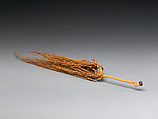Fly whisk (Hossu)
Hayakawa Shōkosai III Japanese
Not on view
Like his forebears, Hayakawa Shōkosai III created works related to the sencha tea culture, including this fly whisk of blond, finely branching “ladyfinger” bamboo. The fly whisk is an attribute of Daruma (Bodhidharma), who according to tradition transmitted Chan Buddhism to China; it symbolizes the sweeping away of mental distractions and ignorance. Chinese Daoist sages are often represented using the implement to brush away flies while engaged in “pure conversation” with their friends. In his portrait displayed nearby, Ingen (1592–1673), who introduced the sencha tea culture to Japan, holds a fly whisk. At literati gatherings, they were hung next to the tokonoma (alcove) to indicate that scholarly conversation was taking place.
Due to rights restrictions, this image cannot be enlarged, viewed at full screen, or downloaded.

